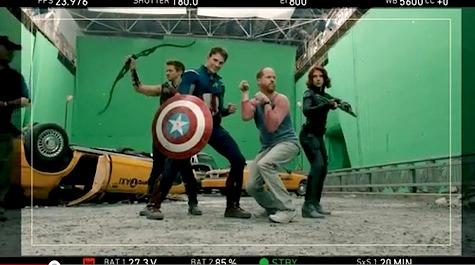The Avengers came out on Blu-Ray and DVD this week, and with that came a very special director’s commentary from the man himself, Joss Whedon. As you can imagine, it’a jam-packed full of all sorts of tidbits, but more interestingly, Whedon’s commentary provides excellent insight into how collaborative filmmaking truly is, especially on a project of such scale. Here are some fun highlights from the commentary track, detailing script changes, actor contributions and more.
Writing/Production Gems
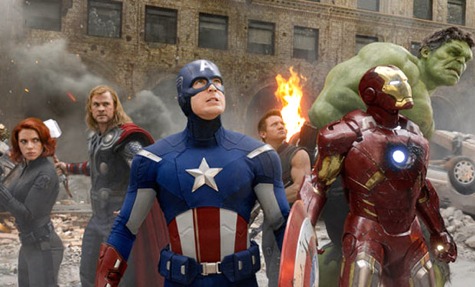
- Whedon credits Kevin Feige for the reason he ended up directing The Avengers. As he rightly pointed out, the film is only his sophomore go (following 2006’s Serenity), but Feige and Whedon have known each other since long before Feige became the producer to all the Marvel projects. He approached Joss and asked him what he would do if given the reins. According to Whedon, he wanted to make the film, “An enormous disaster where we were one step ahead of the crumbling earth every second.” For the crew as well as the characters, naturally.
- After writing and directing Serenity, another large film with a complicated ensemble that tied into a larger work, Whedon promised himself that he would never write a movie like that again. Whoops.
- Originally, Whedon wanted the evil World Council to be more realistic, nice people who were really just doing what they thought was best to keep the world safe. It became clear after filming those scenes (you can see deleted examples of this on the Blu-Ray) that they needed to be more ominous to service the plot – Whedon joked that in the original version, the council looked like they were weather reporters.
- All script weaknesses are duly noted: Whedon himself wasn’t a fan of how the Chitauri basically “had their strings cut” once the mothership was blown up, but it had to be done to prevent the battle sequence from continuing. In regards to the arrow Hawkeye shoots to mess with the helicarrier’s computers, his response was, jokingly, “What? It’s a virus arrow! That could totally happen! Don’t make fun of me.”
- When writing the final battle scenes, Whedon kept war films more in mind than previous superhero films, a tack that he thought was necessary when having to move between so many characters. Moments showing each character doing their thing were typically never cut in the Chitauri battle, even when he thought they would be; they were kept because producers rightly thought that without those moments, we would never get to see these heroes truly become The Avengers.
Set Secrets
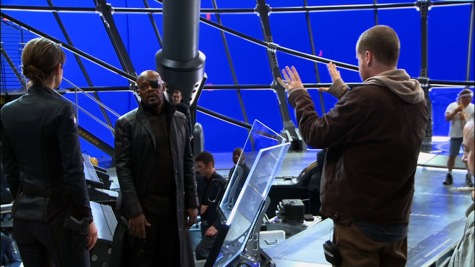
- The helicarrier bridge is actually set up like an eagle, with the computer stations mimicking wings.
- The jet that the Hulk tore up and crashed was the same one from the film True Lies.
- Hulk’s containment cell weighed a full 18 tons. If an actor stood an the center of it, it made a horrible echo, making sound a nightmare. Filming the scene with Thor falling to earth inside of it was one of the hardest things to do because tilting the cell was so difficult.
- The tarmac on the helicarrier was actually a runway in the desert that was baking – the wind effects were added in post. The carrier take off was not in the script originally, but they realized it was needed to help the audience buy into the world. The helicarrier bridge was incredibly slippery, and they shot on it for three weeks. Whedon really wanted to leave by then.
- They considered having the helicarrier create a bank of clouds to hover on rather than using the reflection panels to go invisible, but it was assumed that the carrier moving would then be harder to buy. In the end, they stuck with the panels, which Whedon referred to as a Brosnan-era Bond choice.
- The tunnels used in the first chase scene (Loki leaving with the tesseract) were tunnels used to grow mushrooms, of all things.
- The base where the tesseract was being held by SHIELD at the start of the film was indeed a NASA installation in Ohio.
King Stark
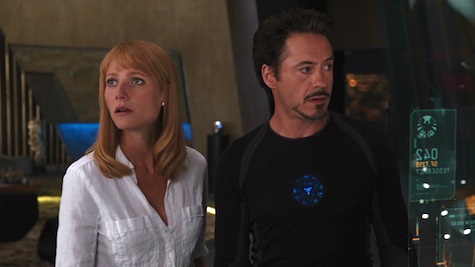
Of course, Robert Downey, Jr. had a lot to say where Tony Stark was concerned, and Whedon was constantly working with him to develop the character and add material to riff with. Here are some prime examples:
- Downey was insistent that Pepper Potts be in the film, wanting to show Tony’s character progressing beyond what we had seen in the first two Iron Man movies. He worked closely with Joss to develop that scene and discuss how Tony and Pepper’s relationship would function. Whedon called the scene his chance to “write 3 minutes of The Thin Man.”
- More of the film was originally going to revolve around the difficulties between Captain America and Iron Man. There was a nasty remark involving Howard Stark (Tony’s dad) that was cut after their capture of Loki in Germany, and originally Tony’s line “We are not soldiers,” was meant to be shouted at Cap. Downey told Whedon that it really didn’t feel right to shout, and Whedon realized that the moment of anger hadn’t been earned without those cut scenes, leading instead to the line delivery we saw in the film.
- “Shakespeare in the park” was a line that Whedon threw to Downey on the day of filming. Downey then ad-libbed “Doth mother know you weareth her drapes?” Similarly, the shawarma aside came up when he asked Whedon for more material following his revival. The director gave him a few options, shawarma among them, which Downey then took and ran with to its glorious conclusion. Saying that the arc reactor was a “terrible privilege” was also an addition of his that Whedon loved.
- The original scene between Stark and Loki was similar to all other scenes where Loki confronted the Avengers with threats. Whedon noticed that the scene didn’t work, and decided to change it to Tony bragging, which worked much better.
Our Favorite Giant Green Rage Monster
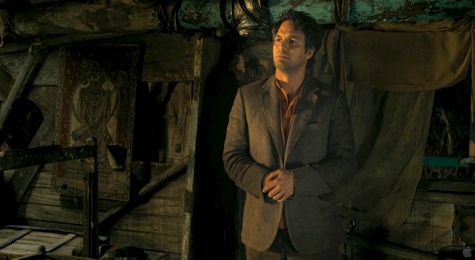
- Mark Ruffalo told Whedon every day for the first week of shooting that it wasn’t too late to recast him. (“Bless him,” Whedon said fondly.) He loved that Ruffalo actually looked like someone on edge, dangerous, rather than an adorable nerdy scientist.
- The line in his scene with Black Widow, “Well, I don’t all the time get what I want,” did not call for the crib that Ruffalo rocked as he spoke. It just happened to be there as set dressing. Whedon noticed it, and was super pleased that Ruffalo agreed used it, giving the line more weight.
- The reason behind having Hulk go after Black Widow in his first transformation was that it had to happen around someone he didn’t like, so the audience believed he might hurt them. Having that transformation was important to Whedon because he wanted to make sure that the audience understood that Hulk’s story was not an entirely heroic one, but a story about the way people choose to handle their rage.
- The intention was to impart that there are two Hulks within Banner — the first one we see, when the change is out of his control, is vicious and brutal. The second Hulk, the one he chooses to become, is the Hulk who can help the team and catch his friends when they fall.
- Whedon worked very carefully with ILM on the Hulk animation. Ruffalo sent the ILM animators a lovely letter saying that they all were playing the part together, and told them to do whatever they needed to do to make it work.
- Harry Dean Stanton’s cameo (Whedon refers to Stanton’s character as Hulk’s “Spirit Guide”) was entirely by chance – one of the crew was doing a documentary on him, so they were able to get him in.
The Big Guys (Or “The Chrises,” If You Prefer)
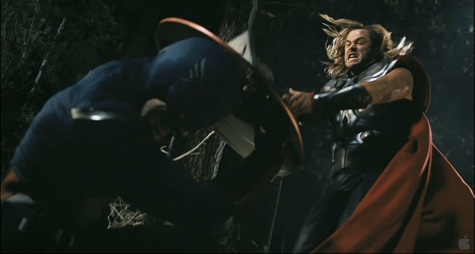
- Chris Evans was worried that the “flying monkeys” line would make Cap seem lame. Of course, he ended up loving the reaction the line got in theaters.
- Whedon realized that he had to have some of the kneeling crowd get to their feet around Cap as he approached Loki before their fight, otherwise his line about seeing “someone standing above everyone else” last time he was in Germany wouldn’t play correctly because he was also standing above everyone.
- Chris Hemsworth told Whedon that he had already played through Thor’s relationship with his father, and wanted to spend The Avengers dealing with the brother dynamic, hence their chat on the mountain top.
- Whedon cops to it – he loves knocking Norse guys out of frame. Oh, Thor.
The Widow and the Hawk
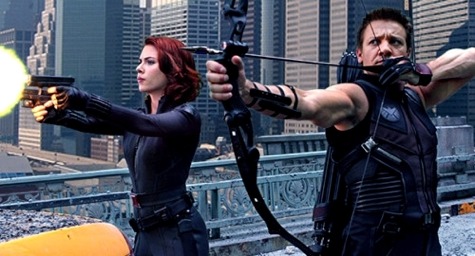
- In the original script, there was a beautiful backstory for Hawkeye and he was on the team from the beginning. Unfortunately, their simply wasn’t enough time to put it into the story, so the brainwashing plotline was created to give Renner something interesting to play with the character. Whedon was pretty sad that they couldn’t do more. He also never got tired of watching Hawkeye shoot things while looking the other way.
- Renner threw his neck out while they were filming the big fight scene between Hawkeye and Black Widow (not while filming the fight, just randomly on set). Scarlett Johannson rearranged her schedule so that she could finish filming the fight with him, instead of both of them fighting with the stunt doubles.
- Hawkeye’s blue “possessed eyes” were added in post very late in the game, to make it more obvious that he and Eric Selvig were under Loki’s influence.
- Whedon studied Russian lit and language in school, so the first scene with Black Widow was a lot of fun for him to write. Interestingly, it was the only scene that stayed exactly how he had written it in his first draft. Whedon noted how much sense that made, given that it was his M.O. – someone is trying to corner a helpless small woman, only to find that she’s not helpless at all. The whole floor in that scene was lightly padded. The stunt coordinators weren’t exactly happy because of Widow’s bare arms in the scene; any time you have bare arms or stockings, they can’t pad the actor and/or stunt double’s elbows and knees.
God of Mischief
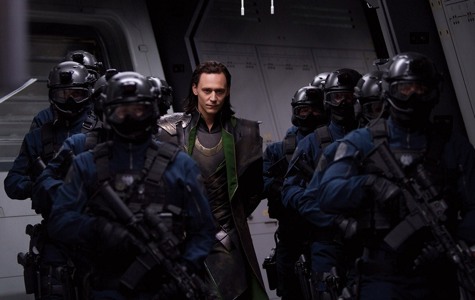
- Whedon first saw Tom Hiddleston in Othello (playing Cassio) and was very excited to find out that he was cast in Thor. He was concerned because Loki’s character was so sympathetic in Thor, and worried that Loki couldn’t carry the film as its main villain. Then he talked to Drew Goddard, who pointed out that Loki had fallen into an abyss at the end of Thor and come out the other side, which was bound to mess him up a little. It allowed Whedon to write Loki more for fun, the way he is typically written in the comics, allowing Hiddleston to play the sadness and subtlety underneath.
- About the now famous (infamous?) “mewling quim” line: Whedon felt that the Elizabethan language was appropriate to the character. He also pointed out that Asgard was not an entirely unsexist place, so it made sense that Loki might not have the most evolved opinions on women. He felt the line did its job because it’s at that moment, when Loki shows that uglier part of himself, that Widow gets the drop on him.
- Banner’s line about how he could “smell crazy” on Loki was part of a larger joke in the earlier drafts; Loki was going to do his multiplying trick on Hulk, then Hulk was going to smell for him, and find the real Loki to smash around.
- If Joss Whedon accomplished anything in the years he spent working on The Avengers, he would have it be the moment Hulk bashed Loki against the concrete floor like a ragdoll.
S.H.I.E.L.D. and Company
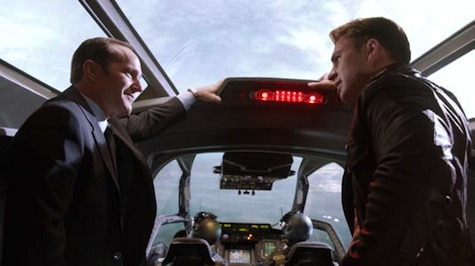
- Cobie Smulders (Agent Maria Hill) is a very physical actor – the duck and roll she performs when Loki escapes with the tesseract is all her.
- After writing the script, Whedon realized that all the humor was too witty, “a desert of dry wit.” He found that adding Coulson’s crush on Captain America lent the film another dimension of humor that it was lacking. The “slight foxing around the edges” line is all Whedon – he’s a collector of old books among other things, and it tickled him to make Coulson that hardcore of a collector and fan.
- The man actually playing Galaga on his SHIELD computer was not part of the original joke in the script – they added it to the screen in post production when they noticed that actor looked shifty.
- Buffy/Angel/Dollhouse actor Alexis Denisof is indeed Thanos’ right hand guy, behind all those prosthetics.
So how’s that for a barrel full of Avengers info? (There’s probably an “assemble” joke in their somewhere, but I got nothing.)
Emmet Asher-Perrin particularly loved the shoutout to Chris Evans’ jaw in the commentary. You can bug her on Twitter and read more of her work here and elsewhere.










